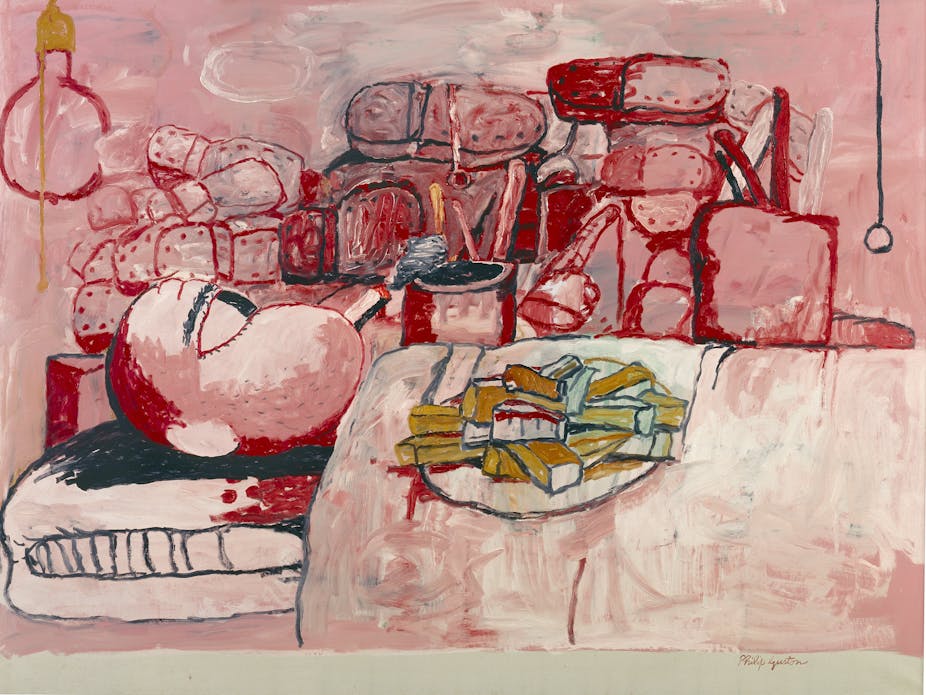American painter Philip Guston’s (1913-1980) work was filled with creative innovation. But the paintings he is best known for are the series of cartoonish hooded figures begun in the late 1960s.
Guston called these painted characters “hoods”. They represented members of Ku Klux Klan (KKK), an organisation that had haunted him since childhood. Painting these figures, Guston wanted to explore the idea of evil. “What would it be like to be evil?” he asked himself.
In Tate Modern’s vast Guston retrospective, which runs until February 25, the “hoods” occupy just one room out of 11. But Guston’s nuanced engagement with racialised evil caused a contentious three-year delay in the exhibition opening.
Produced in collaboration with three major US museums (the Museum of Fine Arts, Boston, the National Gallery of Art, Washington and the Museum of Fine Arts, Houston), the London showing of Guston’s retrospective was originally slated for 2020.
In the atmosphere following the murder of African American George Floyd by a white police officer in Minneapolis, Tate announced that the show would be postponed until “we think that the powerful message of social and racial justice that is at the centre of Philip Guston’s work can be more clearly interpreted”.
Tate was accused of patronising its visitors. The exhibition’s curator Mark Godfrey condemned the decision and resigned. Rumours swirled about Tate’s alleged intolerance of internal dissent.
Tate director Maria Balshaw now claims that the delay allowed time for additional research into Guston’s depictions of the KKK. This is borne out in the exhibition, which begins by establishing key facts about Guston and his artistic commitment to condemning racism.
Guston’s early work
Born Philip Goldstein, Guston – whose later name change masked his Jewish identity – was the son of immigrants who had fled persecution in present day Ukraine. His family settled in the US as the KKK and racialised violence were on the rise.

Guston’s childhood was financially constrained and marred by family tragedies. Largely self-taught, he worked through his fears by drawing “conspiracies and flogging and cruelty and evil” and demonstrated a prodigious artistic talent. This is evidenced in the exhibition through early works including Mother and Child (1930), painted when he was just 17.
From here the exhibition proceeds chronologically. We accompany Guston through his experiments, first with surrealism, then with political murals.

Footage specially shot for Tate’s exhibition shows The Struggle Against Terrorism (1934-35) a monumental, collaboratively made protest mural that Guston painted in Mexico.
In the 1950s, encouraged by his high school friend and fellow artist, Jackson Pollock as well as Willem de Kooning and Mark Rothko, Guston began painting abstract compositions. In 1962, he received his first major retrospective at New York’s Guggenheim Museum which included several paintings shown in the Tate exhibition, such as Passage (1957-58).
‘What if I died?’
The global political turmoil of the late 1960s – addressed by the work of a younger generation of emergent “contemporary” artists – marked the end of a line for Guston’s generation. Pollock died in 1956, killed in an alcohol-fuelled car crash. Rothko took his own life in 1970. De Kooning succumbed gradually to dementia and isolation. Guston began again.
“What if I died?” Guston mused, perhaps thinking of these friends. “What would I paint if I came back?”

From the late 1960s, he abandoned abstraction, restricted his palette to mostly pink and black and began to work on the “hoods”. As younger artists fixated on photographic mass media, Guston invoked the comic strip Krazy Kat. He borrowed its strong black outlines and simplified forms to depict the Klansmen.
A mob of them cruise in a ludicrously cartoonish vehicle in City Limits (1969). A single “hood” meditatively smokes and paints a self-portrait in The Studio (1969). The “hoods” inhabit a sickly, empty city painted in City (1968) like unctuous tiers of strawberry blancmange, or a repulsive mountain of tumbling pink flesh.
Introducing the ‘hoods’
First exhibited in in 1970, the “hoods” had a hostile reception. Discouraged, Guston stopped painting for over a year. He spent the time travelling and finally settled in upstate New York, where he worked in seclusion until his death.
In spite – or maybe because – of the crisis incited by the “hoods” critical rejection, the paintings Guston made next are a tremendous synthesis of his preceding work.

Powerful colours return, along with forms that are recognisable, but dreamlike and strange. In one room, his large canvases are juxtaposed with ink drawings made in collaboration with his partner, the poet and painter Musa McKim (1908-1992).
McKim composed words around which Guston drew: “I thought I would never write anything again”, says one. “Then I put on my cold wristwatch.”
The final room in the exhibition is filled with work done at night and dominated by the colour black. Couple in Bed (1977), painted after McKim suffered a stroke, shows the pair apparently asleep. Guston clings to McKim, clutching his paintbrushes and still wearing his “cold wristwatch”.

After seeing Guston’s Tate retrospective, I led an undergraduate seminar analysing the New Right’s political rhetoric. The discussion turned to memes and how their crude comic simplifications serve far-right agendas well.
The exchange made me think back to Guston’s Blackboard (1969) a painting of three hooded Klansmen on a schoolroom board. Did Guston mean to show the educational apparatus that engenders racism? Or was this a prompt to think about the interpretive frameworks that get placed around controversial works of art, including his own?
I’d like to think it was both. Guston wanted to pass on tools that we could use to take apart everything – form, colour, identity, politics – and to help us put it back together, in an improved form.

Looking for something good? Cut through the noise with a carefully curated selection of the latest releases, live events and exhibitions, straight to your inbox every fortnight, on Fridays. Sign up here.

